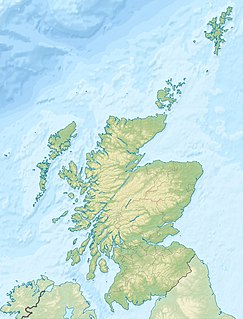
The Lance (Creek) Formation is a division of Late Cretaceous rocks in the western United States. Named after Lance Creek, Wyoming, the microvertebrate fossils and dinosaurs represent important components of the latest Mesozoic vertebrate faunas. The Lance Formation is Late Maastrichtian in age, and shares much fauna with the Hell Creek Formation of Montana and North Dakota, the Frenchman Formation of southwest Saskatchewan, and the lower part of the Scollard Formation of Alberta.

The Cloverly Formation is a geological formation of Early Cretaceous age that is present in parts of Montana, Wyoming, Colorado and Utah in the western United States. It was named for a post office on the eastern side of the Bighorn Basin in Wyoming by N.H. Darton in 1904. The sedimentary rocks of formation were deposited in floodplain environments and contain vertebrate fossils, including a diverse assemblage of dinosaur remains. In 1973, the Cloverly Formation Site was designated as a National Natural Landmark by the National Park Service.
The Wayan Formation is a geological formation in Idaho whose strata date back to the latest Early Cretaceous and the earliest Late Cretaceous. Dinosaur, other reptile, mammal, and micro and macro-floral remains are among the fossils that have been recovered from the formation. The lack of extensive outcrops, limited geographic extent, and extreme structural deformation have limited paleontological explorations of the Wayan.
The Eagle Sandstone is a geological formation in Montana whose strata date back to the Late Cretaceous. It is a light to brownish gray to pale yellow-orange, fine-grained sandstone. It contains areas of crossbedding and local shale members. It contains large sandy calcareous concretions. Its thickness varies from 100 to 350 feet due to the lens nature of the individual sandstone layers and local interbedded sandy shale layers.
The Frontier Formation is a sedimentary geological formation whose strata date back to the Late Cretaceous. The formation's extents are: northwest Colorado, southeast Idaho, southern Montana, northern Utah, and western Wyoming. It occurs in many sedimentary basins and uplifted areas.
The Almond Formation is a geological formation in Wyoming whose strata date back to the Late Cretaceous. Dinosaur remains are among the fossils that have been recovered from the formation.
The Pinyon Conglomerate is a geological formation in Wyoming whose strata date back to the Late Cretaceous. Dinosaur remains are among the fossils that have been recovered from the formation.
The Medicine Bow Formation is a geological formation in Wyoming, United States, whose strata date back to the Late Cretaceous. Dinosaur remains are among the fossils that have been recovered from the formation.
The Evanston Formation is a geological formation in Wyoming whose strata date back to the Late Cretaceous. Dinosaur remains are among the fossils that have been recovered from the formation.
The Arapahoe Formation is a geological formation of latest Cretaceous (Maastrichtian) age that is present within the Denver Basin that underlies the Denver, Colorado, area. The formation includes fossil leaves and dinosaur remains, although none of the latter have yet been referred to a specific genus. It also includes aquifers that are important sources of water for the area.
The Crevasse Canyon Formation is a coal-bearing Cretaceous bedrock formation in New Mexico and Arizona.

The Moenave Formation is a Mesozoic geologic formation, in the Glen Canyon Group. It is found in Utah and Arizona.

The Point Lookout Sandstone is a Cretaceous bedrock formation occurring in New Mexico and Colorado.
The Popo Agie Formation is a Triassic geologic formation that outcrops in western Wyoming, western Colorado, and Utah. It was deposited during the Late Triassic in fluvial (river) and lacustrine (lake) environments that existed across much of what is now the American southwest. Fragmentary fossils of prehistoric reptiles and amphibians, including pseudosuchian reptiles and temnospondyl amphibians, have been discovered in the Popo Agie Formation. Dinosaur remains are also among the fossils that have been recovered from the formation, although none have yet been referred to a specific genus.

The Williams Fork Formation is a Campanian (Edmontonian) geologic formation of the Mesaverde Group in Colorado. Dinosaur remains are among the fossils, most notably Pentaceratops sternbergii, that have been recovered from the formation, although none have yet been referred to a specific genus. Other fossils found in the formation are ammonites, Neosuchia, and the mammal Meniscoessus collomensis.
The Harebell Formation is a Mesozoic geologic formation in Wyoming. Dinosaur remains diagnostic to the genus level are among the fossils that have been recovered from the formation.

The Mowry Shale is a Late Cretaceous geologic formation. The formation was named for Mowrie Creek, northwest of Buffalo in Johnson County, Wyoming. The Mowry crops out or occurs at depth in parts of Colorado, Montana, North Dakota, South Dakota, Utah and Wyoming. It occurs within the following geologic regions:
The Thomas Fork Formation is a Mesozoic geologic formation in Wyoming. Fossil dinosaur eggs have been reported from the formation.

The Lossiemouth Sandstone is a Middle to Late Triassic age geological formation. It is exposed on the south side of the Moray Firth near Lossiemouth and near Golspie in Sutherland. Dinosaur remains are among the fossils that have been recovered from the formation.

The Mesaverde Group is a Late Cretaceous stratigraphic group found in areas of Colorado, New Mexico, Utah, and Wyoming, in the Western United States.










